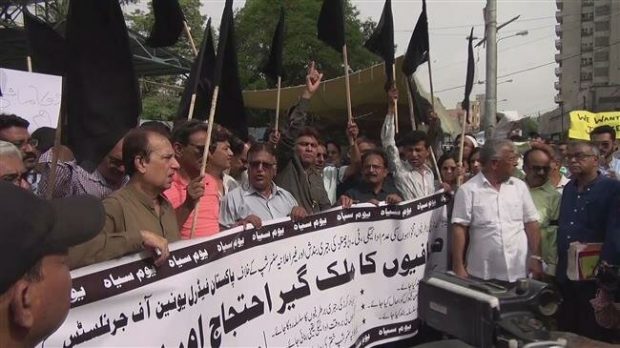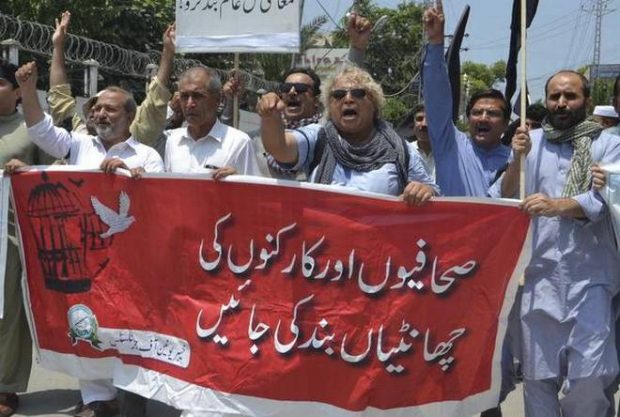Pakistan media faced with bleak future as layoffs reach alarming levels

Journalists in Karachi stage demo against censorship and other repressive policies of government (File Photo)
By Nasir Aijaz
AsiaN Correspondent
Islamabad: People working in the media in Pakistan are faced with bleak future, as more and more journalists and workers are being laid off on the pretext of steering the media out of financial crisis.
Measures include the closure of electronic as well as print media houses, the downsizing of different stations, the merging different offices of newspapers and the slashing of the number of pages.
In the latest move, an Urdu-language TV channel and newspaper ‘Dunya News’ laid off around 300 employees, including journalists, on Thursday, spreading a new wave of uncertainty among people working in Pakistan’s media. This media house had sacked 200 employees earlier this year.
“The media house, based in Punjab province’s capital Lahore, has relieved around 300 employees from its Head Office and four other stations including Islamabad, Karachi and Peshawar,” Ahmed Khan Malik, Secretary, Karachi Union of Journalists (KUJ) said.
Pakistan’s media industry, once viewed as among the most vibrant in South Asia, started laying-off journalists and media workers by shutting down several outlets, such as ‘Waqt TV’ and the bureau offices of several TV and print media outlets in Peshawar, Quetta and Multan cities.
The Jang Group – country’s largest media group, shut down three of its publications and two bureau offices in one single day.
The Express Media Group and Nawa-e-Waqt Media Group also laid-off over 200 journalists, apart from cutting the salaries of the remaining workers by 15 to 35 percent in recent months.
Even traditionally steady employers, such as the Dawn Media Group, imposed 35 percent pay cuts and closed its Herald Magazine, an icon of Pakistani journalism.
The BOL TV, launched a few years ago offering handsome salaries to its employees, also relieved hundreds of people and holding their salaries.
“In all around five thousand journalists and media workers have been rendered jobless during last one year across Pakistan and more are feared to lose their jobs with reports of further downsizing in various media houses,” Malik told.

Khyber Union of Journalists’ members staging demo against retrenchment (File Photo)
Partly affected by the outcome of the July 2018 elections, which brought to power a party (Pakistan Tehreek-e-Insaf) led by Prime Minister Imran Khan not seen as friendly to business, and partly by an ailing economy coupled with the withdrawal of government subsidies and dwindling advertising revenue, even big and stable media groups were forced to shut their publications and sack journalists.
“The media is no longer making the money it did a few years ago”, according to media owners and managers.
But surprisingly, at the end of 2018, a total of 88 TV channels (including news and entertainment channels) and 209 radio stations were licensed, according to the Annual Report 2018 of the Pakistan Electronic Media Regulatory Authority (PEMRA) while in early 2019, PEMRA licensed another 48 channels, including 14 news channels.
Media market information is hard to get but the official news agency Associated Press of Pakistan (APP) reported in 2017 that there had been a cumulative investment of four billion dollars in the electronic media industry in Pakistan between 2002 and 2017 and was estimated to touch five billion dollars by the end of 2018.
“Amid such claims of development and expansion, only the journalists and other employees of media houses find them plunged in precarious situation, as on the one hand, owners continue lay-offs while on the other, they are getting new licenses of TV channels,” Malik said.
There are concerns that the government and the media house owners are working on the same line of re-shaping the media sector and introducing the ‘controlled media’ into the country.
























































